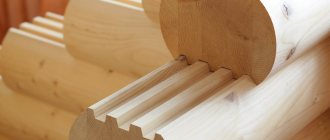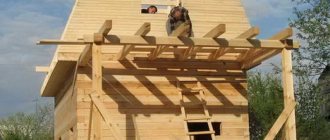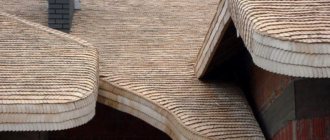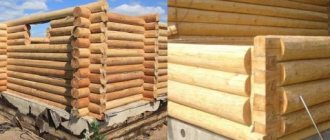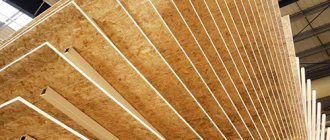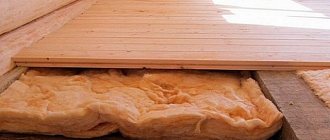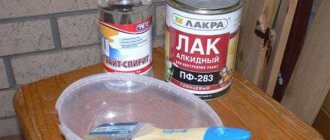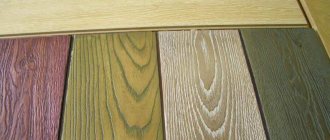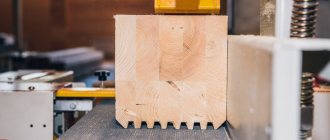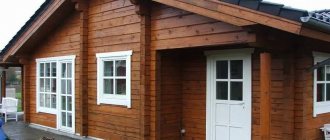Hello, dear friends!
Having your own country house or dacha, remote from active civilization, is the dream of many. Moreover, this dream does not look like a rickety shack with cracks in the walls and a leaky roof. No, people see a full-fledged house, neat, interesting on the outside and fully comfortable on the inside. For those who have such dreams and who see their future masterpiece made of timber, our conversation for today is profiled timber: the pros and cons of this natural material.
In Russia, for the most part, construction timber is made from softwood. Most often pine trees grow in the northern regions. This is justified, since natural pine resin reduces rotting and gives strength to the material. And the northern climate reduces the percentage of natural wood moisture. Only the whole (heart) part of the tree is used.
How is profiled timber made?
Profiled timber is a type of lumber made from solid coniferous wood: it is usually made from pine and spruce; cedar or larch can also be used for production. This material combines the advantages of rounded logs or classic planed timber. Its sides can be flat or semicircular; the decorative qualities of future walls depend on this. The upper and lower sides have a special profile - the tongue-and-groove system ensures that the crowns fit tightly to each other when assembling the log house.
Profiling makes walls more durable and energy efficient - the tongue-and-groove profile provides them with effective protection from blowing and the formation of cracks. In addition, it prevents deformation during natural shrinkage, holding the crowns securely against each other. Houses made of profiled timber reliably retain heat. This allows you to spend less on heating.
There are two types of material:
- Naturally dried wood. The blanks are stored in special conditions for a long time to complete the natural drying process. As a result, the moisture content of the wood does not exceed 22%, which makes it suitable for use in construction.
- Kiln-dried wood. The workpieces are placed in special chambers, where maximum natural moisture is quickly removed from them. Dried wood can be immediately used for construction.
During production, we use workpieces that have undergone preliminary inspection to identify defects. The tree should not be damaged by rodents, insects or mold. Since the central part of a tree trunk is used to make timber, the material has the highest density - this ensures its durability.
German and Finnish profile types
German has another name - comb. It is created by selecting grooves and tenons in the required quantity. This makes it possible to protect the building from wind, low temperatures and avoid the use of insulating materials. When the tenon is tightly installed in the groove, a reliable and warm inter-crown connection is obtained, which prevents cold air from penetrating into the room.
The Finnish one has a wide groove at the bottom, and small tenons about 1 cm high on the sides. This allows you to increase the size of the supporting platform and improve the fit of the crowns. This type of section prevents the penetration of cold and ensures uniform shrinkage. Due to the side spikes, the insulation laid in the inter-crown seams will not be noticeable.
But it is worth noting that profiled timber may lose its thermal insulation qualities if storage conditions are not met. If the material is exposed to sunlight, rain, or snow for a long time, the interlocking joints may become deformed or swell. After such storage it will be impossible to pack the crowns tightly.
Key advantages of using the material
Timber logs are used in the construction of summer country houses, permanent cottages for year-round use, as well as for bathhouses, garages, and various outbuildings. We can list the main advantages of profiled timber:
- Affordable price. This material is significantly cheaper than laminated timber or brick, which makes it more affordable for owners of suburban areas.
- Environmental friendliness. Solid wood retains the ability for natural air exchange: it takes excess moisture from the home atmosphere and releases it back as needed. As a result, it is always comfortable to be in the premises, and it will be easy to breathe in such a house.
- Strength and durability. With proper assembly and regular treatment, the walls can last for decades; the house will not require major repairs. However, he will need regular maintenance care and attention from his owner.
- Light weight. Natural wood is one of the lightest building materials; it does not require a deep concrete foundation. This further reduces construction costs, since it is the foundation that requires large investments.
- Speed of construction. The kit for assembling a log house is pre-made at the production site, and then the house is assembled from ready-made elements. All of them are carefully adjusted to each other, which eliminates the formation of cracks in corners and walls.
- Good thermal insulation qualities. Wood retains heat much better than concrete or brick, which allows you to save on insulation and maintain a comfortable indoor temperature.
- Effective sound insulation. Wooden walls block street sounds, making the rooms quiet and comfortable.
- Excellent decorative qualities. If the sides of the timber are given a semicircular shape, the log house will resemble a log house. Interior walls can be made perfectly smooth for ease of decorative finishing. They do not require rough work; various design ideas can be brought to life.
One of the positive features of this material is its relatively low shrinkage, not exceeding 3.5-6%. Preliminary natural or chamber drying allows you to remove most of the moisture from the material, thereby eliminating further deformation and the formation of cracks. The house will not need caulking as often as a log house made of logs or planed timber with natural moisture. Considering all the advantages, we can conclude: profiled timber is perfect for implementing a wide variety of construction projects.
Glued laminated timber
As the name suggests, it consists of dry and even lamellas glued together. The use of this technology makes it possible to practically eliminate the process of shrinkage after completion of construction. The following positive points can be highlighted:
- low thermal conductivity;
- impregnation against mold, rot, fire;
- high performance;
- smooth surface does not require additional finishing;
- the outer side can be rounded to imitate a log.
Are there any disadvantages to profiled timber?
Like other building materials, this variety has its drawbacks. The disadvantages of profiled timber must be taken into account before starting construction and when drawing up estimates:
- Susceptibility to various biological influences. A tree without proper care will inevitably be destroyed by rot, mold, fungus, and can be damaged by wood-boring insects and rodents. To avoid premature destruction, it is necessary to carry out timely treatment with special antiseptics - such impregnations penetrate deeply into the structure of the wood and block the action of bacteria, fungi and pests.
- Fire hazard. Wood is a flammable material, so during construction it is necessary to strictly observe all possible measures to prevent fire. It is necessary to take into account all the features of laying electrical wiring through walls and ceilings, and follow the rules for installing heaters. Also, wood must be treated with fire retardants - special compounds increase resistance to fire.
- High requirements for material quality. If the beam is made with irregularities in the profile geometry, it is impossible to achieve a tight fit of the crowns to each other. As a result, there will be cracks in the walls that are difficult to caulk. To avoid such problems, you need to be careful when choosing lumber.
- Higher cost compared to conventional planed timber. If the material undergoes preliminary chamber drying, this will also affect its final price.
Although the shrinkage of profiled timber is relatively small, it still exists, and this must be taken into account during construction. Special devices are used to compensate for changes in the size of the tree - this helps to avoid the appearance of cracks and other negative consequences.
The main disadvantage of a house made of this material is the need for mandatory periodic maintenance. Without the owner's attention, the walls will inevitably lose strength, resulting in a service life that will be much shorter than what was planned by the manufacturer. However, any country home needs support and periodic maintenance; this is a prerequisite for durability.
Summary
Let's sum up the final grades.
+ Advantages of houses made of timber
- Special aesthetics, style of architecture and interior;
- Ideal environmental friendliness of the house, subject to the rules of its operation and careful selection of materials for interior decoration and furnishings;
- Simplicity and high speed of construction;
- Economical construction.
— Disadvantages of houses made of timber
- Wood is susceptible to rotting and damage by insects, the need for careful care, updating the caulk;
- Wood is susceptible to rotting and damage by insects, the need for careful care, updating the caulk;
- Potential fire hazard, the need for particularly careful compliance with fire safety standards;
- Low energy efficiency, cold walls, intense heat loss.
Which timber to choose for construction
The total cost of building a wooden house also depends on the cost of finishing work. In the case of wooden beams, you can choose two construction options:
- Reduce the cost of building walls by using inexpensive non-profiled timber and incur significant costs for finishing work.
- Use high-quality, higher-cost types of timber, thereby reducing finishing costs.
Construction options from profiled timber
Turnkey houses made of profiled timber in Yekaterinburg remain one of the most popular solutions on the construction market. This material opens up wide possibilities for design: with its help you can bring a variety of projects to life.
Various options for the construction of timber cottages are possible:
- One-story houses of various sizes. They can be quite large in size; a one-story building is most convenient for use. However, it requires quite a lot of space on the site.
- Two-story buildings. The ground floor usually houses the kitchen, living room, bathroom and other common areas, while the bedrooms are located upstairs. The presence of a second floor allows you to reduce the space occupied on the site, but you have to solve the problem of placing stairs and other issues.
- One-and-a-half-story buildings are houses with attics. This is an intermediate option in which the second floor is combined with the under-roof space used.
Our company offers affordable prices for house projects made of profiled timber in Yekaterinburg - ready-made standard solutions meet all comfort requirements.
Warm timber
It has all the characteristics of the glued one described above. It also uses multilayer slats. It differs in that between the sides there is a layer of synthetic heat-insulating material - extruded polystyrene foam. The gluing process under high pressure produces a building element with unique properties. The lumber has the appearance of profiled timber, but has low thermal conductivity. Without the use of additional insulation, they can withstand frosts down to -50 °C.
Possibilities of external and internal decoration of the house
External cladding for such a building is not mandatory. Treatment with antiseptics and fire retardants will be sufficient to prevent exposure to external negative factors. The building will look beautiful from the outside; smooth wooden walls can be painted in any color or covered with transparent varnish. There are many special compounds that provide excellent protection for wood, but at the same time preserve its natural pattern.
Interior decoration also depends only on the wishes of the residents in terms of decorative qualities. The natural color of wood may seem boring to some, but this material opens up wide possibilities for design. Several popular interior finishing options:
- The walls are sometimes sheathed with plasterboard sheets and covered with wallpaper, but in this case all the decorative advantages of a wooden house are lost. You can paint them with special compounds: paints and odorless translucent azures do not cover the natural texture, so the rooms will be beautiful.
- It is not advisable to cover a wooden ceiling with plaster, since due to the shrinkage of the wood it will begin to crumble over time. You can choose the appropriate coloring and filing option: the floor beams can be left visible and painted - this allows you to create an unusual, stylish decor.
- The floor can be finished using parquet, special floorboards, or parquet boards. Natural materials will look most harmonious in the interior and will also provide additional thermal insulation. The parquet will be warm and pleasant to the touch.
One of the advantages of building a house from profiled timber is the opportunity to significantly save on finishing. The wood does not need to be leveled, plastered, or covered with plasterboard - just choose the appropriate coloring option to create a cozy and modern interior.
Construction site use – pros and cons
Profiled timber is produced using high-precision equipment. Therefore, with the correct manufacturing process, the material is obtained with precise shapes. But this only applies to species produced in large production facilities.
Unfortunately, we have quite a few “handicraft” ones. Having purchased material from such a company, the user receives low-quality products and is disappointed. Building a house from timber of this quality causes many problems. This is why there are so many negative reviews online.
Of course, you can purchase a milling machine and cut the tenon and groove at home. But achieving factory accuracy without special skills is difficult. After all, large manufacturers have automated the entire process and were able to achieve accuracy down to mm. Of course, this only applies to large manufacturers.
Before starting from all sorts of reviews, you need to understand that profiled timber comes in two types:
- Natural humidity.
- Chamber drying.
And this is a completely different lumber with separate characteristics. If the quality of your home is important to you, then it is better to opt for chamber drying or build a house from laminated veneer lumber. Reviews for each type are usually combined into one, and this misleads many buyers. Let's try to figure it out:
| Characteristics of profiled timber, what is emphasized when choosing | Feedback on natural moisture material | Feedback on chamber drying material | Expert opinion |
| Humidity | Most negative reviews concern the material with natural moisture. When it dries, it will twist, crack and lose its geometry. | Kiln-drying material undergoes careful screening. Even during drying, those links that have cracked and lost their shape will be selected. Only high-quality goods are delivered to the buyer. | Of course, you can purchase chamber drying, but unfortunately it is very difficult to find a product with the actual required humidity. Typically, timber with a larger cross-section, for example 200x200, is not completely dried; as a result, the natural moisture remains inside. And such a beam will bend and break no less. The second problem is that the structure of the timber is fibrous and it absorbs all moisture from the environment. If you purchase kiln-drying timber that you are going to store under a canopy, and it’s raining outside, then within two days you will receive material with natural moisture. You can avoid this by purchasing winter goods. |
| Quality | Natural moisture can be of good quality if produced in a large facility. | It undergoes careful selection, so in most cases it is of high quality. | The quality of the material is directly related to the choice of the manufacturer. If you purchase from “handicrafts,” then you should not expect good material, even chamber drying. |
| Availability | There is always | To order | A cross-section larger than 200x200 is becoming increasingly difficult to purchase for more than 2 cubes. It must be pre-ordered. |
| Profile | Several variants | Several variants | The simpler the profile, the more convenient it is to work with it. Although it is believed that the "comb" profile is better, this is a misconception. All the same, over time you will have to insulate the walls additionally. |
| Ease of installation | Convenient | Convenient | Construction from profiled lumber is directly related to the qualifications of builders - carpenters. For self-assembly, only ready-made kits are convenient. |
| Price | From 9,000 rub. | From 13,000 rub. | This construction option cannot be called cheap. Especially when it comes to chamber drying. And you shouldn’t believe that additional finishing will not be needed. |
The main thing that should be done before purchasing such material when building a house from profiled timber is to control its quality before delivery to the construction site. And the rest will depend on the skills and abilities of the construction team. The moisture content of the timber greatly affects its quality characteristics.
Both dry and wet timber are made from the same type of wood with a moisture content of 40-50%. When drying, the humidity decreases to 20%. Based on reviews, the main advantages of chamber timber:
- Eco-friendly. But this can be said about any type of lumber, except laminated veneer lumber.
- Minimum shrinkage of up to 3%, almost like building a house from laminated veneer lumber. This is enough to make the wall askew. This means that chamber drying requires considerable subsequent investments and careful processing.
- During chamber drying, timber with increased knotiness is rejected. Indeed, you can purchase the highest quality goods from large manufacturers in dried form.
- Construction of a house from profiled timber is possible in the shortest possible time. It will take the same amount of time to build a house from dry or natural moisture material. Simply, with chamber drying, you can immediately begin finishing and lay a finished roof.
- Less cracking. Yes, if the correct technology is followed, and in Russia this is only 10-20% of the total, there will be fewer cracks.
- Does not require additional finishing or caulking. This is a misconception, but it will be difficult to caulk profiled timber.
- The dried material has increased water resistance and lower thermal conductivity. This is also a misconception. Indeed, such walls will retain heat better. But the timber will not acquire water resistance after chamber processing. To do this, it must be treated with special compounds. And their quality also depends on the price. It is unlikely that manufacturers will prefer an expensive treatment option.
- The dimensions allow this type of timber to be used in buildings of any complexity. Indeed, timber for building houses has sections of 150x150 or 200x200 mm, which makes it most convenient to use. The standard length is 2.4.6 m. But what does this have to do with the moisture content of the lumber?
You can talk a lot about the advantages of this type of timber, but it’s better to watch the video of professionals:
Of course, you can purchase a glued profile. This will give you dry material. We have already discussed reviews of laminated veneer lumber in a previous article.
Laying communications in a house made of profiled timber: important features
It’s hard to imagine a comfortable country house without a full range of modern amenities. The building must be equipped with electrical wiring, water supply, sewerage, heating, and properly equipped ventilation. A wooden house requires compliance with several important rules when connecting communication networks:
- The water pipeline is laid at a depth below the ground freezing level - this will allow you to use it all year round without any problems. The entry point requires mandatory insulation. A well with a submersible pump is usually installed as a source of water supply.
- To collect sewage, a septic tank, cesspool or modern biotreatment station is installed. When laying an internal sewer pipeline in timber walls and ceilings, compensation holes must be made due to possible deformation of the walls.
- The heating system in a wooden house starts only after the shrinkage is complete; it cannot be turned on until the wood has dried. Most often, water heating is installed with water circulating through pipes and radiators.
- Electrical wiring must be laid in metal tubes to prevent fire in the walls. This is one of the fire safety requirements.
Our company offers a full range of services for the construction of houses from profiled timber with subsequent connection to all types of communications. The finished housing will be warm, cozy and durable, and proper care will ensure its trouble-free operation. The affordable cost of lumber and construction work has made this option one of the most popular in the country house building market.
Price for profiled material
The price of profiled lumber of natural moisture depends on a number of characteristics:
- The type of wood from which it is made (The most expensive are larch and aspen, the cheapest are pine and spruce, which are mainly used for building houses).
- Type of profile (a comb is more expensive than a simple one).
- Processing (whether the material is polished or not, whether it has straight outer and inner sides or rounded block houses).
- Batch size (Wholesale price applies to purchases from 1 cubic meter).
- Delivery to the construction site (The distance of the construction site from the manufacturer will affect costs).
- Seasonality (in winter, when construction is not so active, the price drops).
| Type of wood | Price for different sections of natural humidity, rub./m3 | ||
| 200x200 | 150x150 | 100x100 | |
| Pine (spruce) | From 8 000 | From 7 000 | From 5 000 |
| Larch | From 12 000 | From 10 000 | From 8 000 |
| Aspen | From 11 000 | From 9 000 | From 7 000 |
| Birch | From 6 000 | From 5 000 | From 4 500 |
Wet timber also comes in different qualities, and when choosing to build your house, you need to take into account some factors that will help you purchase the material cheaper:
- Winter timber will have a moisture content of less than 20%, but will be considered wet, since excess liquid freezes out in the cold.
- In winter, the price of the material is reduced by 15-20%; you can buy timber and store it under a canopy. But you shouldn’t cover it entirely with film, otherwise it will quickly rot and begin to rot.
- To build a house, you shouldn’t overpay when purchasing profiled timber with natural humidity; it’s easier to buy a simple one. the finishing will have to be the same, and the price will be halved.
- Natural humidity in summer can be dried under a canopy, and then you can move into the house immediately after construction.
- The material should have an even color without blackness. This is the first sign of the development of microorganisms and the timber will quickly begin to rot.
You can buy profiled timber with natural humidity from any manufacturer, the main thing is that it has been tested and has been working on the market for more than 5 years. You should not trust reviews posted on the manufacturer’s website. Such reviews are written by the companies themselves or ordered for money. It is better to communicate directly with customers who have already purchased material in this place. Only half the battle depends on choosing the right material. You can avoid many troubles by following all installation technologies and high-quality waterproofing of the foundation.
